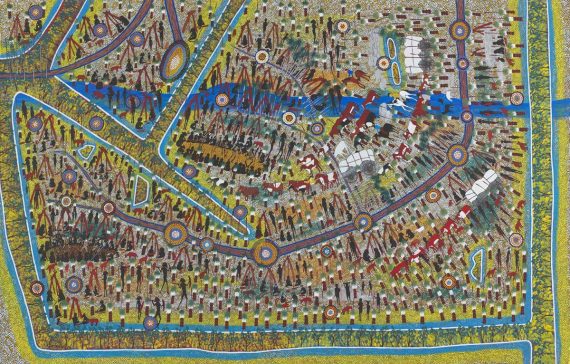We acknowledge the Traditional Owners of the land on which the Queensland Art Gallery | Gallery of Modern Art stands and recognise the creative contribution First Australians make to the art and culture of this country.
History
The Carnarvon Ranges includes several sacred sites of great cultural significance to Aboriginal Australia, the preservation of which plays an important role maintaining cultural practices and connection to country. The Ranges are also home to a significant pastoral history.

Indigenous History
The Carnarvon Ranges has a long human history. Archaeological evidence, including faunal remains, stone tool assemblages, rock art and ancient burial sites, indicate thousands of years of indigenous history and culture in the area. The Bidjara and Garingbal peoples are the traditional custodians of the Ranges; however, the site holds an important place within the histories of many Aboriginal language groups.
Explore D Harding’s contemporary response to the rock art of the Carnarvon Ranges through Wall painting in Rickett’s Blue 2017. Research the 2018 incident in Baloon Cave in Carnarvon National Park that saw fire irreparably damage the art in the cave and consider what steps can be taken to protect similar sites of cultural significance.

Colonial History
The history of colonisation in Central Queensland is an untold history of war. The frontier wars in the region stem from the Land Acts of 1860 that aimed to open up supposedly unoccupied lands in the new colony of Queensland. This policy was built upon the belief that Indigenous people did not have the right of sovereignty.
In the period between 1848 and 1862 — before and after the Land Acts of 1860 — records show that 392 Aboriginal people and 31 colonists were killed within a 310-kilometre radius of the Carnarvon Ranges. Of the 392 Aboriginal deaths, 207 of those occurred between 1860 and 1862. Many more were killed via the poisoning of food and water, and even more deaths were not recorded.
Learn about the massacres in the region by exploring Vincent Serico’s Carnarvon Collision (Big map) 2006 and through The University of Newcastle’s interactive map Colonial Frontier Massacres in Australia 1788–1930

Cattle and Gas
Learn about the Hon James Tyson MLC — the most influential pastoralist in Carnarvon’s history. Regarded as Queensland’s first millionaire, Tyson played a key role in saving the colony’s economy from an imminent collapse in 1893.
Consider the significance of gas as a source of energy — currently the topic of Australia’s Federal Energy Policy. Read about the record-breaking Roma Brisbane Pipeline, which was photographed by Max Dupain in his Gas works at Roma, Queensland c.1970.

What's in a name?
Patrick and James Kenniff were outlaws who were suspected of stealing cattle from Carnarvon and surrounding stations. Charged with murder, the Kenniff Brothers led police on one of the largest manhunts in Queensland history, before being arrested after three months on the run in 1902. Their story plays into the Australian legend of bushrangers.
Read more about the Kenniff Brothers, also known as Australia’s last bushrangers. Consider the significance of Kenniff Cave in the Carnarvon Ranges and whether the story of the Kenniff Brothers warrants the naming rights of Kenniff cave within the Carnarvon Ranges.

Dream Tracks
Read an article written by Robert S. Fuller who studies Indigenous Cultural Astronomy at the University of New South Wales. Fuller has mapped a songline that connects the Carnarvon Ranges with the Bunya Mountains and into northern New South Wales.

Acts of Destruction
The biodiversity of the Carnarvon Ranges was severely impacted by Government policies and economic factors. The Marsupial Destruction Acts in force in Queensland between 1877 and 1930 encouraged the culling of native species in return for bounties paid on presentation of scalps. Millions of wallabies, kangaroos, bandicoots, dingoes, foxes and kangaroo rats — all regarded as “pests” by landholders — were destroyed under these acts.
Government declarations of “open seasons” on koalas and possums resulted in widespread destruction of these species. The native fur trade proved to be a lucrative industry for the area during this period. For example, the skins of Carnarvon possums (known as Carnarvon Blues) were highly sought after for their thicker coats and distinctive blue colouring.
Generations of grazing hard-hooved sheep and cattle has eradicated many of the native grasses of the Ranges, replacing it with speargrass. The loss of native grasses which once sustained the ecology of the region threatens the existence of native species even today.